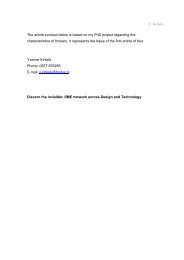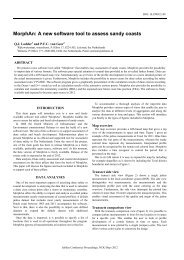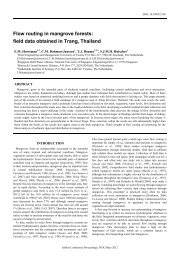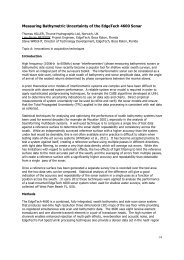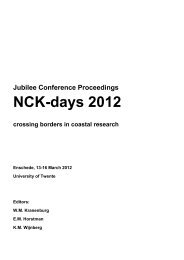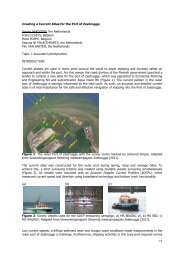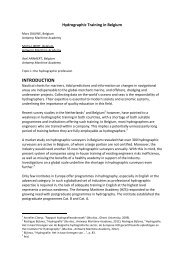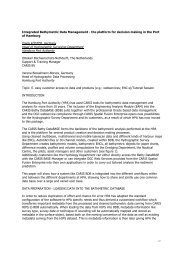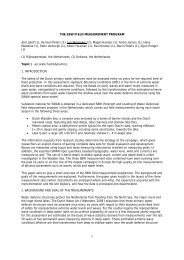The Klofsten Business Platform as a self ... - UT Proceedings
The Klofsten Business Platform as a self ... - UT Proceedings
The Klofsten Business Platform as a self ... - UT Proceedings
You also want an ePaper? Increase the reach of your titles
YUMPU automatically turns print PDFs into web optimized ePapers that Google loves.
Paper for HTSF Conference 2006<br />
Title:<br />
<strong>The</strong> <strong>Klofsten</strong> <strong>Business</strong> <strong>Platform</strong> <strong>as</strong> a <strong>self</strong>-diagnostic tool for new<br />
technology-b<strong>as</strong>ed small firms.<br />
Authors:<br />
John Yencken<br />
Murray Gillin<br />
Australian Graduate School of Entrepreneurship<br />
Swinburne University of Technology<br />
John Street<br />
HAWTHORN VIC 3122<br />
Tel: (03)9214 5870<br />
FAX (03)9214 8381<br />
E-mail jyencken@groupwise.swin.edu.au.<br />
1
<strong>The</strong> <strong>Klofsten</strong> <strong>Business</strong> <strong>Platform</strong> <strong>as</strong> a <strong>self</strong>-diagnostic tool for new<br />
technology-b<strong>as</strong>ed small firms.<br />
Abstract<br />
This paper first reviews available instruments that might be used by new technology-b<strong>as</strong>ed<br />
small firms (NTSFs) <strong>as</strong> <strong>self</strong>-diagnostic tools to plan their future development strategies. It<br />
makes a clear distinction between tools that are for <strong>self</strong>-diagnostic internal use by such<br />
ventures and the more established tools, such <strong>as</strong> Timmons “fatal flaw analysis” and Bell-<br />
M<strong>as</strong>on, designed to <strong>as</strong>sist venture capital investors in decisions whether to invest or not in a<br />
new company. <strong>The</strong> paper then analyses the application of the <strong>Klofsten</strong> <strong>Business</strong> <strong>Platform</strong><br />
with its eight Cornerstones <strong>as</strong> a comparative diagnostic tool in over twenty c<strong>as</strong>e studies to the<br />
understanding of the early stages of development of new technology-b<strong>as</strong>ed spin-off ventures<br />
from Australian and Scottish universities. <strong>The</strong> analysis is longitudinal over a period of up to<br />
six years for surviving companies. Survival rates for the sample have been compared with<br />
overall survival rates of spin-off and other new ventures in Australia.<br />
Acknowledgements<br />
<strong>The</strong> authors would like to acknowledge the permission from Professors Magnus <strong>Klofsten</strong> and<br />
Per Davidsson to translate and use the Swedish questionnaire originally developed by them<br />
and for ongoing help throughout this research.<br />
Introduction<br />
<strong>The</strong> literature on new venture creation and development describes a number of models that<br />
might be used for the <strong>as</strong>sessment of new business ventures. Most of these have <strong>as</strong> their focus<br />
helping potential equity investors (friends, family and fools, business angels and venture<br />
capitalists) in their decisions whether to invest or not in that particular venture (Bell and<br />
M<strong>as</strong>on, 1991; Mainprize et al., 2003; M<strong>as</strong>on and Stark, 2002; Timmons, 1994). <strong>Klofsten</strong><br />
(1998) h<strong>as</strong> developed a <strong>Business</strong> <strong>Platform</strong> concept that w<strong>as</strong> designed <strong>as</strong> a <strong>self</strong> administered<br />
diagnostic to <strong>as</strong>sist small and medium sized knowledge b<strong>as</strong>ed companies to <strong>as</strong>sess for<br />
themselves their status in relation to what <strong>Klofsten</strong> identified <strong>as</strong> the <strong>Business</strong> <strong>Platform</strong>:<br />
To survive and develop, a firm must reach a business platform early on. <strong>The</strong>rewith, the firm<br />
h<strong>as</strong> achieved a condition where the initial vulnerabilities have been overcome, although this<br />
is not any guarantee that the firm will survive…A business platform is not a goal in it<strong>self</strong>,<br />
but the first very important step towards a stable growing firm (<strong>Klofsten</strong>, 1998: 13).<br />
From this concept, Davidsson and <strong>Klofsten</strong> (2003) developed a questionnaire instrument that<br />
a firm might complete to evaluate its status in relation to this <strong>Business</strong> <strong>Platform</strong> objective.<br />
This questionnaire w<strong>as</strong> evaluated by a survey of Swedish knowledge b<strong>as</strong>ed businesses.<br />
Responses were received from 114 firms with a 36 per cent response rate. Of these firms, 58<br />
per cent were providers of services and 35 per cent providers of products. <strong>The</strong>ir average age<br />
w<strong>as</strong> 6-7 years and median age 7.0 years (Davidsson and <strong>Klofsten</strong>, 2003:7). In this earlier<br />
research the focus w<strong>as</strong> on helping existing knowledge b<strong>as</strong>ed companies.<br />
<strong>The</strong> research reported here involved c<strong>as</strong>e studies of newly established companies spun out by<br />
universities and other publicly funded research providers, twenty in Australia and two in<br />
Scotland. <strong>The</strong> c<strong>as</strong>e studies were b<strong>as</strong>ed on well established principles (Yin, 1994; Miles and<br />
Huberman, 1994; Eisenhardt, 1989). One of the research objectives w<strong>as</strong> to test the validity of<br />
<strong>The</strong> <strong>Klofsten</strong> <strong>Business</strong> <strong>Platform</strong> concept <strong>as</strong> the b<strong>as</strong>is of a <strong>self</strong>-diagnostic tool and to explore<br />
its relevance for newly established New Technology-B<strong>as</strong>ed Firms (NTSF), not just for<br />
knowledge b<strong>as</strong>ed companies with six or seven years’ history.<br />
2
<strong>The</strong> authors finally reviewed the survival rates for spin-off companies against other new<br />
ventures in Australia and elsewhere to provide benchmarks to <strong>as</strong>sess the survival rates of the<br />
c<strong>as</strong>e study sample.<br />
Reaching the <strong>Business</strong> <strong>Platform</strong><br />
<strong>The</strong> sample of companies<br />
<strong>The</strong> research involved c<strong>as</strong>e studies over the period FY1999 to 2002of twenty two spin-off<br />
companies established in Australia and Scotland, most of which were incorporated in the<br />
period FY 1995-2000. <strong>The</strong> parent research provider organisations included both large<br />
(research expenditure greater than A$100million per annum) and small/medium research<br />
profile universities, CSIRO (the Australian national public research agency), and Cooperative<br />
Research Centres (CRCs). CRCs are an Australian Commonwealth Government initiative to<br />
bring together in the one organisational structure universities and other research providers<br />
with industry and other users of research (See www.crc.gov.au). <strong>The</strong> unit of analysis w<strong>as</strong> the<br />
spin-off company. <strong>The</strong> population w<strong>as</strong> theoretically sampled to ensure inclusion of a wide<br />
range of technologies and parent research providers, with wherever possible two spin-off<br />
companies from each research provider (Yencken, 2005).<br />
<strong>The</strong> individual c<strong>as</strong>e studies involved both quantitative data collection using a developed<br />
survey instrument (Yencken, 2005:340) and qualitative research b<strong>as</strong>ed on interviews with<br />
researcher inventors, managers, technology transfer staff and first investors.<br />
<strong>The</strong> survey instrument<br />
At the time when the research reported here w<strong>as</strong> started, only a Swedish version of the survey<br />
instrument w<strong>as</strong> available. This w<strong>as</strong> translated into English in Australia by a fluent Swedish<br />
speaker. Inevitably there are small differences in translation between this earlier translation of<br />
the original Swedish instrument used here and the later translation of the survey instrument<br />
included in Davidsson and <strong>Klofsten</strong> (2003). However to avoid any incompatibilities, the same<br />
translated-in-Australia version w<strong>as</strong> used both for the initial surveys in 1999-2001and the reinterviews<br />
in 2005. <strong>The</strong> changes made to the original Swedish questionnaire included<br />
deletion of one statement that did not appear relevant in the Australian environment and<br />
expansion of the Likert response value scale from one to five to one to seven. This latter<br />
change w<strong>as</strong> well validated in the responses. Respondents regularly used all scores from one<br />
to seven. <strong>The</strong> Likert seven-value opposing statements used to explore the c<strong>as</strong>e study<br />
company’s status in relation to the eight Cornerstones have been included <strong>as</strong> Appendix A.<br />
<strong>The</strong> complete version of the questionnaire is available in one of the present authors’ thesis<br />
(Yencken, 2005: 340). <strong>The</strong> analysis of the data in the comparative data questionnaire, b<strong>as</strong>ed<br />
on the Davidsson/<strong>Klofsten</strong> Cornerstones and <strong>Business</strong> <strong>Platform</strong> (Davidsson and <strong>Klofsten</strong>,<br />
2003), had a similar objective. It me<strong>as</strong>ured how close a business w<strong>as</strong> to reaching its <strong>Business</strong><br />
<strong>Platform</strong>.<br />
<strong>Klofsten</strong> (1998: 7) defined the <strong>Business</strong> <strong>Platform</strong> <strong>as</strong> meaning that “the newly-started firm h<strong>as</strong><br />
achieved a state where vulnerability h<strong>as</strong> decre<strong>as</strong>ed to the point that the firm h<strong>as</strong> been able to<br />
move on to the next ph<strong>as</strong>e of its further development”:<br />
<strong>The</strong> likelihood that a company would generate sustainable growth w<strong>as</strong> determined by its<br />
ability to satisfy the eight pillars of <strong>Klofsten</strong>’s <strong>Business</strong> <strong>Platform</strong> (<strong>Klofsten</strong> and Davidsson,<br />
2001) and how this ability varied over time. A key output or dependent variable in each<br />
individual c<strong>as</strong>e study w<strong>as</strong> how it scored (on a scale 1 to 7) on each of these pillars and against<br />
some average of these scores. <strong>The</strong> eight pillars included:<br />
3
<strong>The</strong> firm’s development process:<br />
• IDEA <strong>The</strong> formulation and clarification of the idea behind the firm<br />
• PRODUCT <strong>The</strong> development of finished products accepted by customers<br />
• MARKET <strong>The</strong> definition of the market, .eg niche large enough to be profitable<br />
• ORGANISATIONAL DEVELOPMENT<br />
Actors close to the firm, such <strong>as</strong> the founders, the CEO and board members:<br />
• CORE GROUP EXPERTISE. Market knowledge, marketing and sales expertise,<br />
technical expertise<br />
• PRIME MOVER & COMMITMENT <strong>The</strong> actors’ driving force and commitment.<br />
External supply of resources in supplementary are<strong>as</strong> necessary to the firm:<br />
• CUSTOMER RELATIONS <strong>The</strong>se relations are important for all firms since they are<br />
the source of revenue<br />
• OTHER FIRM RELATIONS A variety of different relationships; particularly important<br />
are suppliers of financial backing and supplementary knowledge<br />
<strong>The</strong> mean scores in for the Swedish sample of 119 established knowledge b<strong>as</strong>ed companies<br />
have been shown <strong>as</strong> Figure1. A Likert five-value scale w<strong>as</strong> used for this survey.<br />
For the Australian sample, data on the eight Cornerstones identified by <strong>Klofsten</strong> were<br />
obtained using Likert seven-value opposed statements in the comparative data questionnaire<br />
(Appendix A). Mean values of these scores for the set of statements relating to each<br />
Cornerstone have been shown in Table 1 and Figure 2. <strong>The</strong> table h<strong>as</strong> only shown scores at the<br />
time of questionnaire completion. <strong>The</strong> individual c<strong>as</strong>e study reports also included scores Two<br />
years ago (Yencken, 2005).<br />
Comparison between the mean Cornerstone scores achieved by the sample of established<br />
Swedish companies (median age seven years) b<strong>as</strong>ed on a five-value scale (Figure 1) and<br />
those for the Australian companies b<strong>as</strong>ed on a seven-value scale (Figure 2) are very similar<br />
except for the two Cornerstones that related to established relationships <strong>The</strong> low scores for<br />
Customer relations in the Australian data arose because many of the companies had not yet<br />
made their first sale. <strong>The</strong> low scores for Other relationships generally related to problems<br />
with finance availability. By comparison, for a well established publicly listed Australian<br />
pharmaceutical company (Company X in Table 1), the mean Cornerstone score w<strong>as</strong> 6.54<br />
(Figure 3). Only one c<strong>as</strong>e came close to this score, C<strong>as</strong>e Number One with a mean<br />
Cornerstone score of 6.24 (Figure 4).<br />
Interview data were collected from fifteen such companies in Australia and from two in<br />
Scotland. Three other companies were included in the qualitative research sample, C<strong>as</strong>e<br />
Number Three for reference <strong>as</strong> a typical NTSF entrepreneurial start-up that had had no direct<br />
relationships with a university or other public research agency parent, and two others,<br />
Numbers Four and Eight, which turned out not be spin-off companies but rather companies<br />
that had used in one c<strong>as</strong>e a university and in the other a CRC <strong>as</strong> their contracted technology<br />
source. <strong>The</strong> key details of this sample of companies segmented <strong>as</strong> indicated earlier have been<br />
summarised in Table 2-4.<br />
For the whole sample, only one company (no. 11 average score 5.39) that had an average<br />
Cornerstone score of over five failed, while there w<strong>as</strong> only one company that had an average<br />
score less than 5.0 (no.14 with average score 4.32) and w<strong>as</strong> still active. However this l<strong>as</strong>t<br />
4
company w<strong>as</strong> the oldest company in the sample and it had still not at the time of interview<br />
made its first sale. <strong>The</strong> data therefore suggests that companies with an average Cornerstone<br />
score of less than 5.0 after two to three years of existence are vulnerable. B<strong>as</strong>ed on these data<br />
and having regard to the small sample involved, it is a re<strong>as</strong>onable but tentative conclusion<br />
that the <strong>Klofsten</strong> <strong>Business</strong> <strong>Platform</strong> approach can be used <strong>as</strong> an effective <strong>self</strong>-diagnostic tool<br />
for New Technology-b<strong>as</strong>ed Small Firms, not just well established knowledge-b<strong>as</strong>ed firms <strong>as</strong><br />
originally tested by Davidsson and <strong>Klofsten</strong> (2003).<br />
Validation of the questionnaire responses<br />
Only one individual in each company completed the questionnaire. <strong>The</strong> interview response<br />
data were used to check and validate the relevance and accuracy of these responses. <strong>The</strong><br />
interview transcripts showed no significant divergences from those suggested by the <strong>Business</strong><br />
<strong>Platform</strong> questionnaire. A possible explanation for the high score for C<strong>as</strong>e No. 11, which w<strong>as</strong><br />
later taken over <strong>as</strong> having a need for new management, may have been related to a change in<br />
management immediately after the interview.<br />
Segmentation of c<strong>as</strong>es<br />
<strong>The</strong> unit of analysis h<strong>as</strong> been new technology b<strong>as</strong>ed ventures, particularly those that are spinoff<br />
companies arising from universities or other public research providers where there is an<br />
ongoing intellectual property link back to the parent research provider. Bhavé (1994: 225)<br />
drew attention to the importance of selecting samples of c<strong>as</strong>es on taxonomic dimensions<br />
rather than by the usual more convenient dimensions of industry, size, technology or region.<br />
<strong>The</strong> sample here w<strong>as</strong> theoretically selected on taxonomic dimensions, with NTSF cl<strong>as</strong>s,<br />
technology and type of spin-off parent <strong>as</strong> the primary dimensions. It included seventeen c<strong>as</strong>es<br />
where there were adequate qualitative interview derived data for effective triangulation. <strong>The</strong><br />
sample included four different cl<strong>as</strong>ses of NTSFs:<br />
A. Opportunity driven entrepreneurs, the cl<strong>as</strong>sical domain of entrepreneurship research.<br />
B. Direct Research Spin-off companies where there had been an ongoing intellectual property link<br />
with and often staff transferred across from the parent research provider (Upstill and Symington,<br />
1999; Stankiewitz, 1994; Thorburn, 1997; Hindle and Yencken, 2004).<br />
1. Product oriented mode (PO) companies), organised around a well developed product<br />
(or process) concept and focussed on the advanced development, production and<br />
marketing of that product (or process).<br />
2. Service-oriented mode companies, similar to product oriented mode companies but<br />
developed around a well-developed service concept.<br />
3. Technology <strong>as</strong>set oriented mode (TA companies), concerned with the development of<br />
technologies which are subsequently commercialised through spinning-out new firms,<br />
licensing, joint ventures or other types of alliance rather than by manufacturing<br />
products or delivering services<br />
<strong>The</strong>re were four cl<strong>as</strong>ses of spin-off parent research suppliers: universities with large,<br />
universities with medium to small research profiles, Cooperative Research Centres and<br />
CSIRO <strong>as</strong> a public research agency.<br />
<strong>The</strong> segmentation of the companies <strong>as</strong> shown in Tables 2-4, w<strong>as</strong> b<strong>as</strong>ed on Bhidé’s three types<br />
of new ventures: opportunity driven entrepreneurs, venture capital driven and corporates. <strong>The</strong><br />
cl<strong>as</strong>sification w<strong>as</strong> b<strong>as</strong>ed on the incre<strong>as</strong>ed level of planning and resourcing by the parent<br />
5
efore the company w<strong>as</strong> cut loose from this parent that w<strong>as</strong> most typical for the corporates<br />
(Table 4).<br />
Survival of the fittest<br />
In this section of the paper, available data on the survival rate of spin-offs from universities<br />
and other publicly funded research agencies h<strong>as</strong> reviewed to allow comparisons with the<br />
survival rates of the spin-off companies involved in the c<strong>as</strong>e studies reported earlier.<br />
<strong>The</strong> Australian Bureau of Statistics h<strong>as</strong> only once previously, for FY 1995/96, published data<br />
on cumulative business exit rates and survival rates (<strong>Business</strong> Exits Australia, ABS Cat. No.<br />
8144.0). <strong>The</strong> 1995/96 data showed a survival rate after five years of 65 per cent both overall<br />
and for small companies and after ten years 52 per cent overall. New data (ABS Cat. No.<br />
8160.0) were rele<strong>as</strong>ed on 23 June 2005 for FY 2000/001, 2001/02 and 2002/03. <strong>The</strong>se data<br />
only included survival rates over periods of one and two years from 2001-02. Over the two<br />
year period from 2001-02 to 2003-04 the survival rate for private companies w<strong>as</strong> 94.8 per<br />
cent and for public companies 72.3 per cent. By sector, survival rates for Manufacturing were<br />
87.9 per cent and for Communication Services 82.6 per cent. Unfortunately no more up-todate<br />
data for longer term survival rates in Australia have been produced.<br />
Overse<strong>as</strong> data<br />
<strong>The</strong> only overse<strong>as</strong> data on survival rates for academic spin-off companies h<strong>as</strong> been given by<br />
Mustar (1997: 41) for France. His data showed a survival rate for such spin-offs after five<br />
years of 75 per cent by comparison with the survival rate for all new companies in France of<br />
50 per cent over five years.<br />
It can be seen therefore that the survival rate [after five years] is very high: continued trading<br />
for five out of every six firms and the same legal structure for three out of four firms.<br />
He also drew attention to the importance of networking. For the group of firms that had very<br />
close links with R&D and which had entered into cooperation agreements with other French<br />
or foreign firms, ten had between 50 and 100 employees and two had staffs of 150 and 260<br />
respectively. ‘In the group of firms without a network, half the enterprises had disappeared’<br />
(p.41).<br />
Australian data<br />
An earlier Australian survey of university spin-offs (Yencken and Gillin, 2001:16) suggested<br />
a survival rate of 57 per cent over three to five years and 87 per cent over two to thee years<br />
(Table 5). <strong>The</strong>se data on survival rates were not complete <strong>as</strong> not all companies could be<br />
contacted.<br />
More recently for this paper the current status of all new spin-off companies established in<br />
FY 2000, <strong>as</strong> listed in the Australian National Survey of Research Commercialisation Year<br />
2000 (ARC/NEMIC/CSIRO, 2002) w<strong>as</strong> reviewed by direct contacts with the companies<br />
and/or their research provider parents. For the first time the data in this report allowed a more<br />
systematic exploration of survival rates of spin-offs that originated in universities and<br />
CSIRO, the Australian Government funded research agency. It h<strong>as</strong> been possible to establish<br />
the present status of all these companies five years after their establishment. Two companies<br />
were excluded <strong>as</strong> being technology transfer vehicles rather than direct research spin-offs. <strong>The</strong><br />
findings have been summarised in Table 6.<br />
<strong>The</strong> survival rates for the Australian university spin-off companies established in 2000 over<br />
five years to 2005 have been 68 per cent for the university spin-offs with three (10 per cent)<br />
6
under new ownership following trade sales <strong>as</strong> liquidity events. Seven companies (22 per cent)<br />
have been liquidated and three companies (10 per cent) are not actively trading. <strong>The</strong> survival<br />
rate h<strong>as</strong> been lower than that suggested by the earlier survey of Australian university spinoffs<br />
shown in Table 6 for a shorter period of three years (Yencken and Gillin, 2001). All the<br />
CSIRO spin-offs established in the year 2000 were still trading with six (50 per cent) under<br />
new ownership. <strong>The</strong> survival rate for the university spin-offs is thus comparable with that for<br />
all new ventures established in 1995/96 in the ABS data (ABS Cat. No. 8144.0 <strong>Business</strong> Exits<br />
Australia), while that of the CSIRO spin-offs established in 2000 is higher.<br />
Conclusions<br />
B<strong>as</strong>ed on the data from the c<strong>as</strong>e studies and having regard to the small sample involved, it is<br />
a re<strong>as</strong>onable but tentative conclusion that the <strong>Klofsten</strong> <strong>Business</strong> <strong>Platform</strong> approach can be<br />
used <strong>as</strong> an effective <strong>self</strong>-diagnostic tool for New Technology-b<strong>as</strong>ed Small Firms, not just well<br />
established knowledge-b<strong>as</strong>ed firms <strong>as</strong> originally tested by Davidsson and <strong>Klofsten</strong> (2003).<br />
It remains to compare the survival rates of the companies involved in the c<strong>as</strong>e studies<br />
reported earlier, with a reminder that this sample w<strong>as</strong> theoretically sampled for a wide range<br />
of technologies and parents and is not a statistically valid random sample. <strong>The</strong> survival rates<br />
for the three groups <strong>as</strong> shown in Tables 2-4 have been:<br />
Group A: Opportunity driven entrepreneurial ventures<br />
Four out of seven companies (57 per cent) in this group aged 24 to 72 months had survived<br />
and were active.<br />
Group B: Venture capital driven companies<br />
Neither of the two companies in this group had survived but the intellectual property from<br />
one of them w<strong>as</strong> still being developed after the sale of the original company. In both c<strong>as</strong>es<br />
there w<strong>as</strong> evidence of a lack of an effective champion. In one c<strong>as</strong>e the company w<strong>as</strong> formed<br />
when a deal with a major pharmaceutical company fell through when it withdrew from that<br />
field of medication.<br />
Group C: Corporate style spin-offs<br />
Nine of the twelve companies in this group, ranging from 13 to 180 months in age, had<br />
survived and were active. One of these had been the subject a profitable liquidity event, a<br />
trade sale.<br />
While the numbers are small, these survival rates⎯57 per cent for Group A and 75 per cent<br />
for Group C⎯support the findings from the qualitative research interviews that a higher<br />
survival rate might be expected from spin-offs that been effectively planned and well<br />
nourished with resources before being cut loose from the parent, that is the spin-offs in Group<br />
C that met Bhidé’s (2000) description of corporate style spin-off ventures. <strong>The</strong> Group C<br />
survival rate w<strong>as</strong> also noticeably higher than the underlying survival rate indicated by ABS<br />
<strong>Business</strong> Exits 1995-96 data. <strong>The</strong> qualitative interview data for the two Group B companies<br />
also showed the importance of a commercially oriented champion and the likely outcomes<br />
where this does not occur.<br />
References<br />
ABS (2005) Cat. No.8160.0.55.001 Experimental Estimates of <strong>Business</strong> Entries and Exits,<br />
Australia. Canberra: Australian Bureau of Statistics.<br />
ABS (1997) Cat. No. 8144.0 <strong>Business</strong> Exits Australia.. Canberra: Australian Bureau of<br />
7
Statistics.<br />
Australian Research Council, CSIRO and National Health and Medical Research Council<br />
(2002) National Survey of Research Commercialisation 2000. Canberra: Australian<br />
Research Council.<br />
Bell, C.G. and M<strong>as</strong>on, H.B. (1991) A method to diagnose high tech ventures. Technology<br />
Management: the New International Language, 1991 621-624.<br />
Bhidé, A.F. (2000) <strong>The</strong> Origin and Evolution of New <strong>Business</strong>es,<br />
University Press.<br />
edn. Oxford: Oxford<br />
Davidsson, P. and <strong>Klofsten</strong>, M. (2003) <strong>The</strong> <strong>Business</strong> <strong>Platform</strong>: Developing an Instrument to<br />
Gauge and to <strong>as</strong>sist the Development of Young Firms. Journal of Small <strong>Business</strong><br />
Management 41, 1-26.<br />
Eisenhardt, K.M. (1989) Building <strong>The</strong>ories from C<strong>as</strong>e Research. Academy of Management<br />
Review 14, 532-550.<br />
Hindle, K. and Yencken, J. (2004) Public Research Commercialisation, Entrepreneurship<br />
and New Technology B<strong>as</strong>ed Firms: An Integrated Model. Technovation 24, 793-<br />
2003.<br />
<strong>Klofsten</strong>, M. (1998) <strong>The</strong> <strong>Business</strong> <strong>Platform</strong>: Entrepreneurship and management in the early<br />
stages of a firm's development., edn. Luxembourg: TII - European Association for<br />
the Transfer of Technologies, Innovation and Industrial Information.<br />
<strong>Klofsten</strong>, M. (2005) New Venture Ide<strong>as</strong>: An Analysis of their Origin and Early<br />
Development. Technology Analysis & Strategic Management 17, 105-119.<br />
Mainprize and Hindle (2003) Toward the standardization of venture capitalinvestment evaluation:<br />
decision criteria forrating investee business plans. Frontiers for Entrepreneurship Research<br />
2002. Xiii. Venture capital 23, Boston: Babson College.<br />
M<strong>as</strong>on, C. and Stark, M. (2002) What do investors look for in a business plan? A<br />
comparison of bankers, venture capitalists and business angels. Paper presented at the<br />
25th ISBA National Small Firms Policy and Research Conference Competing<br />
Perspectives of Small <strong>Business</strong> and Entrepreneurship 25th ISBA National Small Firms<br />
Conference: Competing Perspectives of Small <strong>Business</strong> and Entrepreneurship.<br />
Wetherby, UK: International Small <strong>Business</strong> Association.<br />
Miles, M.B. and Huberman, A.M. (1994) Qualitative Data Analysis: An Expanded Source<br />
Book, edn. Thousand Oaks: SAGE Publications.<br />
Mustar, P. (1997) How French academics create hi-tech companies. Science and Public<br />
Policy 24, 1, 17-43.<br />
Stankiewicz, R. (1994) University firms: spin-off companies from universities. Science and<br />
Public Policy 21, 99-107.<br />
Thorburn, L. (1997) Technology Transfer Through Spinoff Companies: CSIRO - 1985 to<br />
1995. Canberra: CSIRO.<br />
Timmons, J.A. (1994) New venture creation : entrepreneurship for the 21st century ,<br />
Fourth edn. Burr Ridge, Ill. : Irwin..<br />
Upstill, G. and Symington, D. (1999) Generating New Companies from CSIRO Technology.<br />
Canberra: CSIRO.<br />
Yencken, J. (2005) An Australian Model for Spin-off Companies in the Commercialisation<br />
8
of University and Other Public Sector Research: <strong>The</strong>sis for PhD Degree. Melbourne:<br />
Swinburne University of Technology. PhD <strong>The</strong>sis. Swinburne University of<br />
Technology.<br />
Yencken, J. and Gillin, M. (2002) Australian University Spin-off Companies: Attitudes,<br />
Policies and Companies. An AGSE Research Paper edn, Melbourne: Australian<br />
Graduate School of Entrepreneurship at Swinburne University of Technology<br />
Research Paper.<br />
Yin, R.K. (1994) C<strong>as</strong>e Study Research: Design and Methods, Second edn. Thousand Oaks,<br />
Ca. USA: SAGE Publications.<br />
9
Appendix A<br />
Statements in <strong>Business</strong> <strong>Platform</strong> Questionnaire<br />
A number of statements follow which deal with the company and its internal and external<br />
relations. <strong>The</strong>se statements are placed in opposite pairs. <strong>The</strong> statements are formulated in the<br />
present, but are always concerned with two timelines: how things are right now, and how<br />
they were two years ago.<br />
Ple<strong>as</strong>e read the two statements. Score the company on the scale between the two according to<br />
which statement fits best. Choose 1 if the left-hand statement fits completely, or 7 if the<br />
right-hand statement fits completely. If the situation of the company w<strong>as</strong>/is right in the<br />
middle, choose 4. If it doesn’t fit completely, but leans more towards one or the other<br />
statement, choose 3 or 5.<br />
Ple<strong>as</strong>e circle one number in each row.<br />
Ide<strong>as</strong><br />
Ide<strong>as</strong> and opportunities on which the<br />
company’s activities should be b<strong>as</strong>ed<br />
are not well specified.<br />
Ide<strong>as</strong><br />
Q.1. Now: 1 2 3 4 5 6 7<br />
Q.2. Two years ago: 1 2 3 4 5 6 7<br />
<strong>The</strong>re is uncertainty about which<br />
ide<strong>as</strong> and opportunities should have<br />
priority for development and<br />
investment.<br />
Q.3. Now: 1 2 3 4 5 6 7<br />
Q.4. Two years ago: 1 2 3 4 5 6 7<br />
It is unclear which needs of which<br />
type of customer the company’s new<br />
ventures can satisfy.<br />
Q.5. Now: 1 2 3 4 5 6 7<br />
Q.6. Two years ago: 1 2 3 4 5 6 7<br />
It is rather difficult to say what is<br />
special and unique about the<br />
company’s development ide<strong>as</strong>.<br />
Q.7. Now: 1 2 3 4 5 6 7<br />
Q.8. Two years ago: 1 2 3 4 5 6 7<br />
Products<br />
<strong>The</strong>re is a clear understanding on which<br />
ide<strong>as</strong> and opportunities the company’s<br />
activities should be b<strong>as</strong>ed.<br />
Everybody in the company is completely<br />
clear about which ide<strong>as</strong> and have priority<br />
for development and investment<br />
It is completely clear which needs of<br />
which type of customer the company’s new<br />
ventures can satisfy.<br />
It is completely clear what is special and<br />
unique about the.company’s development<br />
ide<strong>as</strong>.<br />
<strong>The</strong>re is no developed, market-ready<br />
product.<br />
<strong>The</strong>re is a well-developed product that is<br />
completely ready to sell.<br />
Q.9. Now: 1 2 3 4 5 6 7<br />
Q.10. Two years ago: 1 2 3 4 5 6 7<br />
No user h<strong>as</strong> tested the product.<br />
<strong>The</strong> product h<strong>as</strong> been tested with<br />
various possible users.<br />
10
Q.11. Now: 1 2 3 4 5 6 7<br />
Q.12. Two years ago: 1 2 3 4 5 6 7<br />
No identified customer can<br />
Various identified customers can<br />
confirm the product’s usefulness.<br />
confirm the product’s usefulness.<br />
Q.13. Now: 1 2 3 4 5 6 7<br />
Q.14. Two years ago: 1 2 3 4 5 6 7<br />
<strong>The</strong> company h<strong>as</strong> no limitations on<br />
the customer categories to which it<br />
should sell.<br />
<strong>The</strong> Market<br />
Q.15. Now: 1 2 3 4 5 6 7<br />
Q.16. Two years ago: 1 2 3 4 5 6 7<br />
It is difficult to say what<br />
characterises the company’s<br />
customers who have the greatest<br />
likelihood of purch<strong>as</strong>ing from the<br />
company..<br />
Q.17. Now: 1 2 3 4 5 6 7<br />
Q.18. Two years ago: 1 2 3 4 5 6 7<br />
<strong>The</strong> company sells to a very specific<br />
customer category.<br />
<strong>The</strong>re are a number of criteria that<br />
define exactly the potential customers<br />
who have the greatest likelihood of<br />
purch<strong>as</strong>ing from the company.<br />
<strong>The</strong> usefulness that the company’s<br />
Usefulness of the product to the customer<br />
products can give to customers is built<br />
is fully specified after contact with the<br />
on <strong>as</strong>sumption from within the company.<br />
customer.<br />
Q.19. Now: 1 2 3 4 5 6 7<br />
Q.20. Two years ago: 1 2 3 4 5 6 7<br />
<strong>The</strong> market is cultivated primarily<br />
through random contacts.<br />
<strong>The</strong> company works with a structured<br />
strategy for market cultivation.<br />
Q.21. Now: 1 2 3 4 5 6 7<br />
Q.22. Two years ago: 1 2 3 4 5 6 7<br />
<strong>The</strong> company cultivates a large number<br />
of customer categories.<br />
<strong>The</strong> company makes a clear prioritisation of<br />
certain customer categories over others<br />
Q.23. Now: 1 2 3 4 5 6 7<br />
Q.24. Two years ago: 1 2 3 4 5 6 7<br />
Organisation<br />
All staff do most types of t<strong>as</strong>ks.<br />
All staff have clearly demarcated t<strong>as</strong>ks.<br />
Q.25. Now: 1 2 3 4 5 6 7<br />
Q.26. Two years ago: 1 2 3 4 5 6 7<br />
<strong>The</strong>re are no specific<br />
organisational units.<br />
<strong>The</strong> company can clearly be described<br />
in an organisational chart.<br />
Q.27. Now: 1 2 3 4 5 6 7<br />
Q.28. Two years ago: 1 2 3 4 5 6 7<br />
<strong>The</strong> staff were recruited from the<br />
founder’s personal network of<br />
contacts<br />
Staff in the company were deliberately<br />
recruited for their special skills.<br />
11
Q.29. Now: 1 2 3 4 5 6 7<br />
Q.30. Two years ago: 1 2 3 4 5 6 7<br />
<strong>The</strong> company’s activities derive from<br />
reactions to situations and events.<br />
<strong>The</strong>re is disciplined and goal-oriented work to<br />
develop the company.<br />
Q.31. Now: 1 2 3 4 5 6 7<br />
Q.32. Two years ago: 1 2 3 4 5 6 7<br />
Everybody in the company h<strong>as</strong><br />
responsibility for most of the<br />
activities involved.<br />
<strong>The</strong>re is a clear division of authority<br />
and responsibility in the company.<br />
Q.33. Now: 1 2 3 4 5 6 7<br />
Q.34. Two years ago: 1 2 3 4 5 6 7<br />
<strong>The</strong> company lacks knowledge about<br />
the markets for its products.<br />
Expertise and competencies<br />
Q.35. Now: 1 2 3 4 5 6 7<br />
Q.36. Two years ago: 1 2 3 4 5 6 7<br />
<strong>The</strong> company is very well supplied with<br />
knowledge about the markets for its<br />
products<br />
<strong>The</strong> company lacks expertise in<br />
marketing and sales<br />
<strong>The</strong> company is very well supplied with<br />
expertise in marketing and sales<br />
Q.37. Now: 1 2 3 4 5 6 7<br />
Q.38. Two years ago: 1 2 3 4 5 6 7<br />
<strong>The</strong> company lacks the specific<br />
competencies needed in its field.<br />
<strong>The</strong> company is very well supplied with<br />
Peak expertise in its field.<br />
Q.39. Now: 1 2 3 4 5 6 7<br />
Q.40. Two years ago: 1 2 3 4 5 6 7<br />
<strong>The</strong>re is a lack of leadership<br />
experience and expertise in the<br />
company.<br />
Q.41. Now: 1 2 3 4 5 6 7<br />
Q.42. Two years ago: 1 2 3 4 5 6 7<br />
<strong>The</strong> technical expertise that exists<br />
in the company doesn’t cover its<br />
needs for the future.<br />
<strong>The</strong> company is very well supplied with<br />
leadership experience and expertise.<br />
<strong>The</strong> technical expertise that exists in<br />
the<br />
completely covers its needs for the<br />
future.<br />
Q.43. Now: 1 2 3 4 5 6 7<br />
Q.44. Two years ago: 1 2 3 4 5 6 7<br />
Every staff member is responsible<br />
for the development of his own<br />
expertise and competencies.<br />
Q.45. Now: 1 2 3 4 5 6 7<br />
Q.46. Two years ago: 1 2 3 4 5 6 7<br />
<strong>The</strong>re is a planned and systematic<br />
development of expertise and<br />
competencies for each individual staff<br />
member.<br />
12
<strong>The</strong> founder’s foremost aim with the<br />
company is to create employment for<br />
him<strong>self</strong> and possibly some friends<br />
Driving Forces<br />
Q.47. Now: 1 2 3 4 5 6 7<br />
Q.48. Two years ago: 1 2 3 4 5 6 7<br />
<strong>The</strong> founder sees the company<br />
<strong>as</strong> one of several income<br />
creating opportunities.<br />
<strong>The</strong> founder’s foremost aim with the<br />
company is to “surprise the world” and.<br />
build a growing company.<br />
<strong>The</strong> founder is fully focused on a<br />
future <strong>as</strong> a business person within the<br />
company.<br />
Q.49. Now: 1 2 3 4 5 6 7<br />
Q.50. Two years ago: 1 2 3 4 5 6 7<br />
Commitment by people involved<br />
to the company could be<br />
characterised <strong>as</strong> modest.<br />
Q.51. Now: 1 2 3 4 5 6 7<br />
Q.52. Two years ago: 1 2 3 4 5 6 7<br />
<strong>The</strong> company h<strong>as</strong> not yet sold any<br />
products or services to any<br />
customers.<br />
Customer Relations<br />
Q.53. Now: 1 2 3 4 5 6 7<br />
Q.54. Two years ago: 1 2 3 4 5 6 7<br />
Everyone involved h<strong>as</strong> a very strong<br />
commitment to the company.<br />
<strong>The</strong> company h<strong>as</strong> a large number of<br />
customers who have bought its products<br />
or services.<br />
It is not likely that any customers<br />
will make repeat purch<strong>as</strong>es.<br />
<strong>The</strong> company’s customers regularly<br />
make repeat purch<strong>as</strong>es.<br />
Q.55. Now: 1 2 3 4 5 6 7<br />
Q.56. Two years ago: 1 2 3 4 5 6 7<br />
It is difficult to make sales to new<br />
customers<br />
<strong>The</strong> company regularly brings in lots of<br />
new customers<br />
Q.57. Now: 1 2 3 4 5 6 7<br />
Q.58. Two years ago: 1 2 3 4 5 6 7<br />
Customers are rarely satisfied. Customers are always very<br />
satisfied.<br />
Q.59. Now: 1 2 3 4 5 6 7<br />
Q.60. Two years ago: 1 2 3 4 5 6 7<br />
One person directs all of the<br />
customer contacts.<br />
Customer contacts are spread among all<br />
of the staff.<br />
Q.61. Now: 1 2 3 4 5 6 7<br />
Q.62. Two years ago: 1 2 3 4 5 6 7<br />
Other Relationships<br />
<strong>The</strong>re are no relationships with banks<br />
and investors.<br />
<strong>The</strong>re are good and firm relationships<br />
with banks and investors.<br />
Q.63. Now: 1 2 3 4 5 6 7<br />
Q.64. Two years ago: 1 2 3 4 5 6 7<br />
13
<strong>The</strong> company is lacking in capital.<br />
<strong>The</strong> company h<strong>as</strong> access to all the capital that<br />
it needs for the company’s present and likely<br />
future activities.<br />
Q.65. Now: 1 2 3 4 5 6 7<br />
Q.66. Two years ago: 1 2 3 4 5 6 7<br />
<strong>The</strong>re are no external contacts which<br />
can add to the company’s<br />
"credibility" in the eyes of the<br />
market,<br />
<strong>The</strong> company h<strong>as</strong> good contacts with<br />
government, which strengthen its<br />
“credibility” in the market.<br />
Q.67. Now: 1 2 3 4 5 6 7<br />
Q.68. Two years ago: 1 2 3 4 5 6 7<br />
<strong>The</strong> company h<strong>as</strong> no external contacts or<br />
sources who can bring to the company<br />
extra management expertise<br />
Q.69. Now: 1 2 3 4 5 6 7<br />
Q.70. Two years ago: 1 2 3 4 5 6 7<br />
<strong>The</strong> company h<strong>as</strong> good external contacts<br />
and sources that bring to it extra.management<br />
expertise.<br />
14
Table 1 Australian c<strong>as</strong>e study sample: Cornerstone mean scores Now (at the time of questionnaire<br />
completion)<br />
No. Idea Product <strong>The</strong><br />
Market<br />
Organisation<br />
Expertise<br />
Driving<br />
forces<br />
Customer<br />
relations<br />
Other<br />
relations<br />
Mean<br />
score<br />
1 6.00 7.00 6.00 6.80 5.83 6.33 5.20 6.75 6.24<br />
2 5.00 5.33 5.00 5.00 4.50 6.67 4.40 4.75 5.08<br />
3 6.25 5.33 4.80 4.80 4.33 6.33 3.80 4.00 4.96<br />
4 4.75 6.33 5.60 5.20 5.17 6.00 5.20 3.50 5.22<br />
5 6.00 5.00 6.20 7.00 5.67 5.00 2.80 5.25 5.36<br />
6 6.75 6.67 7.00 5.40 5.33 5.00 2.80 6.75 5.71<br />
7 4.50 1.00 3.20 5.80 4.67 6.33 3.40 5.50 4.30<br />
8 6.00 5.00 6.60 2.20 3.50 5.67 1.00 4.75 4.34<br />
9 3.50 4.67 5.80 5.20 4.17 5.67 4.60 6.00 4.95<br />
10 No<br />
data<br />
11 6.50 5.33 5.60 6.40 4.50 6.00 3.80 5.00 5.39<br />
13 6.00 4.33 4.80 4.80 4.33 2.67 1.80 4.50 4.15<br />
14 6.25 1.33 4.00 6.20 4.83 6.67 1.80 3.50 4.32<br />
15 5.25 7.00 6.60 3.60 4.83 3.33 3.60 1.50 4.46<br />
16 5.00 5.33 5.60 5.40 5.00 6.33 4.20 4.50 5.17<br />
18 7.00 6.33 6.80 6.20 6.00 4.67 2.40 5.25 5.58<br />
19 3.50 4.33 5.20 5.60 3.67 3.00 3.80 3.75 4.11<br />
20 5.75 7.00 4.80 6.00 5.50 5.67 5.60 4.25 5.57<br />
22 4.75 3.67 4.60 4.20 2.33 6.67 3.80 1.25 3.91<br />
24 5.25 6.33 6.20 6.00 4.67 4.67 4.60 3.50 5.15<br />
25 5.50 6.33 5.40 6.40 5.17 5.67 2.80 5.00 5.28<br />
27 7.00 7.00 6.00 5.60 5.00 6.00 4.60 4.00 5.65<br />
28 6.00 7.00 6.40 4.60 5.50 4.67 3.80 3.25 5.15<br />
29 5.00 1.67 4.80 3.80 3.00 5.33 1.00 2.75 3.42<br />
Cornerstone<br />
mean<br />
Company<br />
X(1)<br />
5.54 5.19 5.52 5.31 4.67 5.41 3.51 4.32 4.93<br />
6.75 7.00 6.80 6.60 6.00 6.67 6.00 6.50 6.54<br />
Note (1):Company X w<strong>as</strong> an established publicly listed pharmaceutical company.<br />
Source: C<strong>as</strong>e study reports (Yencken, 2005).<br />
15
Table 2 Interview comparisons: Group A Opportunity driven entrepreneurial ventures<br />
No.<br />
Product or<br />
activity<br />
4 Asset location<br />
hardware and<br />
software<br />
6 Glaucoma<br />
detection<br />
instrument<br />
8 Specialised<br />
light alloy<br />
billets<br />
10 Robotic seabed<br />
drill<br />
15 Neurological<br />
evaluation of<br />
advertising<br />
27 W<strong>as</strong>te water<br />
filtration<br />
28 Minituarised<br />
reflux pH probe<br />
Parent<br />
University,<br />
medium /<br />
small<br />
University,<br />
large<br />
Date of incor<br />
- poration<br />
Age at<br />
c<strong>as</strong>e<br />
study -<br />
months<br />
Mean<br />
Corner -<br />
stone<br />
score<br />
Age at<br />
recontact<br />
-months<br />
Status June<br />
2005<br />
17/11/1995 72 4.93 NA Ce<strong>as</strong>ed<br />
trading<br />
29/10/1999 37 5.70 67 Active<br />
CRC 1994 100 4.93 NA No longer<br />
trading<br />
University,<br />
large<br />
University,<br />
medum /<br />
small<br />
University,<br />
medium/sma<br />
ll<br />
University,<br />
medium/sma<br />
ll<br />
Comment<br />
Voluntary<br />
liquidation<br />
due to<br />
failure to<br />
obtain<br />
START<br />
grant<br />
2/2/2001 15 No<br />
response<br />
NA Active<br />
16/11/1998 51 4.46 NA Liqidated First sold to<br />
US<br />
company.<br />
7/12/98 44 5.65 77 Active<br />
4/7/2000 24 5.15 57 Active<br />
Source: C<strong>as</strong>e studies of spin-off companies from universities and other public research agencies<br />
(Yencken, 2005).<br />
Table 3 Interview comparisons Group B Venture capital driven spin-off ventures<br />
No. Product Parent Date of Age at<br />
Age at<br />
or activity<br />
incorporation<br />
11 N<strong>as</strong>al<br />
filter and<br />
particle<br />
me<strong>as</strong>ure<br />
13 Blood<br />
clotting<br />
factor<br />
University,<br />
large<br />
University,<br />
large<br />
c<strong>as</strong>e study<br />
(months)<br />
Mean<br />
Corner -<br />
stone<br />
score<br />
recontact<br />
(months)<br />
Status June<br />
2005<br />
21/011998 51 5.39 NA Liqidated<br />
28/2/97 62 4.15 NA Taken over<br />
by another<br />
biotech -<br />
nology<br />
company in<br />
2004.<br />
Comment<br />
Incre<strong>as</strong>ed<br />
potential<br />
product range<br />
Source: C<strong>as</strong>e studies of spin-off companies from universities and other public research agencies<br />
(Yencken, 2005)<br />
16
Table 4 Interview comparisons: Group C: Corporate<br />
No. Product<br />
or activity<br />
Parent Date of<br />
incorporation<br />
Age at c<strong>as</strong>e<br />
study<br />
(months)<br />
Mean<br />
Cornersto<br />
ne score<br />
Age at re<br />
- contact<br />
Status<br />
June 2005<br />
Comment<br />
1 Java<br />
encryptio<br />
n software<br />
2 Polymer<br />
adhesion<br />
5 Pain killer<br />
drugs<br />
7 Stem cell<br />
therapy<br />
9 X-ray<br />
imaging<br />
CRC 21/12/2000 12 6.24 NA Sold in<br />
trade sale<br />
in 2003.<br />
CSIRO May 2002 Awaiting<br />
incorpora -<br />
tion<br />
University,<br />
large<br />
University,<br />
large<br />
4.91 NA No longer<br />
trading<br />
13/2/98 14 4.91 87 Active<br />
Voluntary<br />
liquidation<br />
March 2004<br />
12/7/2001 7 4.30 46 Active Now b<strong>as</strong>ed in<br />
Singapore<br />
CSIRO 12/11/1996 64 4.95 NA No longer Sold to<br />
active in overse<strong>as</strong><br />
Australia company<br />
14 Fuel cells CSIRO 27/2/1992 123 4.32 NA Active<br />
16 Biomedi -<br />
cal<br />
polymers<br />
CRC 8/7/1997 62 5.17 NA Active Sold to<br />
overse<strong>as</strong><br />
company<br />
18 Diagnosti<br />
cs<br />
20 Driver<br />
vision<br />
<strong>as</strong>sist -<br />
ance<br />
24 Pig<br />
growth<br />
improvem<br />
ent<br />
25 Pl<strong>as</strong>tic<br />
fibre<br />
optics<br />
29 Very large<br />
scale data<br />
storage<br />
CRC 1987 180 5.58 NA Active Listed public<br />
company<br />
University,<br />
large<br />
24/7/2000 25 5.57 58 Active<br />
CRC 1/6/2001 13 5.15 47 Active<br />
CRC 2/5/2002 15 5.28 NA Active Set up by CRC<br />
spin-off<br />
University,<br />
small /<br />
medium<br />
2/2/1999 42 3.42 NA No longer<br />
trading<br />
Failure due to<br />
high<br />
development<br />
cost and<br />
uncertainty<br />
about the<br />
technology<br />
Source: C<strong>as</strong>e studies of spin-off companies from universities and other public research agencies<br />
(Yencken, 2005)<br />
17
Table 5 Status of Direct Research Spin-offs by year of establishment from Survey of Australian<br />
Universities<br />
Count of<br />
Company<br />
name<br />
Year in which<br />
established<br />
A<br />
Actively<br />
trading<br />
B Not<br />
trading at<br />
present<br />
NE No<br />
longer<br />
exists<br />
NK Not<br />
known<br />
S Sold in<br />
a trade<br />
sale<br />
Grand<br />
Total<br />
Pre 1995 No. 22 3 2 24 3 54<br />
% 40 6 4 44 6 100<br />
1995-97 No 18 4 0 2 3 27<br />
% 67 15 0 7 11 100<br />
1998-2000 No. 68 8 0 0 2 78<br />
% 87 10 3<br />
2001 No. 14 2 0 0 0 16<br />
% 87 13 0 0 0 100<br />
Grand Total No. 122 17 2 26 8 175<br />
% 70 10 1 15 4 100<br />
Source: Yencken and Gillin, 2002:16.<br />
Table 6 Survival rates for university and CSIRO spin-offs: FY 2000 to FY2005<br />
Status /<br />
Parent<br />
Active<br />
Active in<br />
new<br />
ownership<br />
Liquidated Inactive Total<br />
Universities No. 18 3 7 3 31<br />
% 58 10 22 10 100<br />
CSIRO No. 6 6 12<br />
% 50 50 100<br />
Source: Review by the present authors of spin-off companies listed in ARC/NHMRC/CSIRO, 2001<br />
18
Figure 1 Cornerstone scores in Swedish survey (Maximum score 5)<br />
Other Relationships<br />
Mean<br />
Ide<strong>as</strong><br />
5<br />
2.5<br />
0<br />
Product<br />
Market<br />
Customer relations<br />
Organisation<br />
Driving forces<br />
Expertise<br />
Source: Data from Davidsson and <strong>Klofsten</strong>, 2003:14.<br />
Figure 2 Sample mean scores for <strong>Business</strong> <strong>Platform</strong> Cornerstones<br />
Other relationships<br />
Ide<strong>as</strong><br />
7.00<br />
3.50<br />
Products<br />
Customer relations<br />
0.00<br />
<strong>The</strong> Market<br />
Driving forces<br />
Expertise<br />
Organisation<br />
Sample mean score Now<br />
Sample mean score Two years ago<br />
Source: C<strong>as</strong>e studies of spin-off companies (Yencken, 2005:149)<br />
19
Figure 3 Cornerstone mean scores: Established company ‘X’<br />
Other relationships<br />
Customer relations<br />
Ide<strong>as</strong><br />
7.00<br />
3.50<br />
0.00<br />
Products<br />
Market<br />
Driving Forces<br />
Expertise<br />
Organisation<br />
Source: Data collected by present authors.<br />
Figure 4 Cornerstones mean scores: Company No.1<br />
Ide<strong>as</strong><br />
7.00<br />
Other relationships<br />
Products<br />
Customer relations<br />
0.00<br />
<strong>The</strong> Market<br />
Driving forces<br />
Organisation<br />
Now Company no.1<br />
Now Mean<br />
2 years ago Company no.1<br />
2 years ago Mean<br />
Expertise and<br />
competencies<br />
Source: C<strong>as</strong>e studies of spin-off companies (Yencken, 2005)<br />
20




